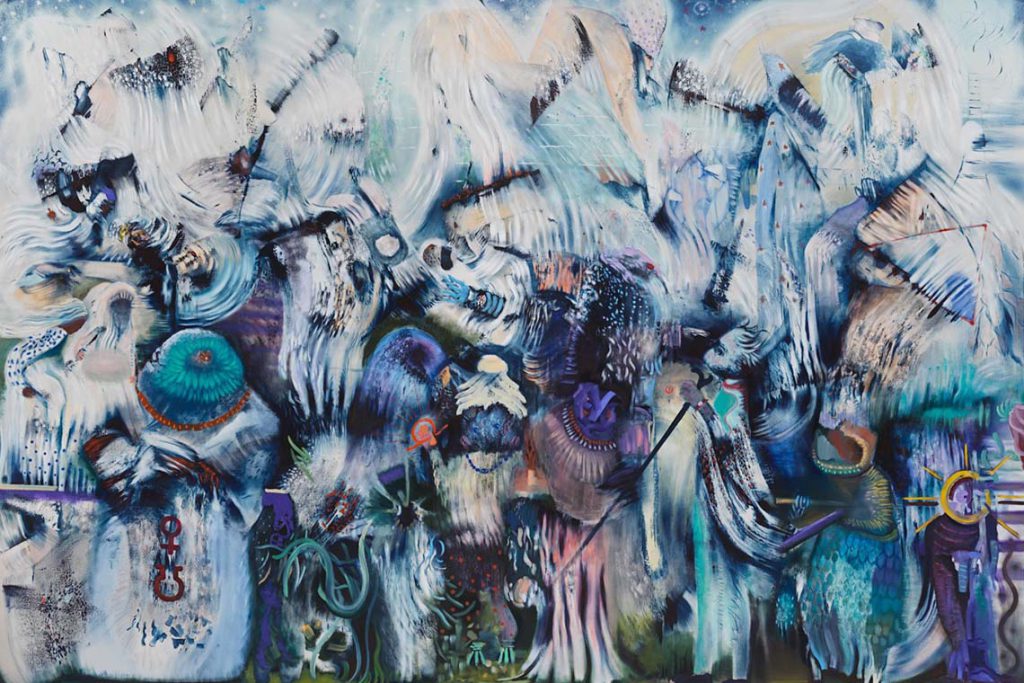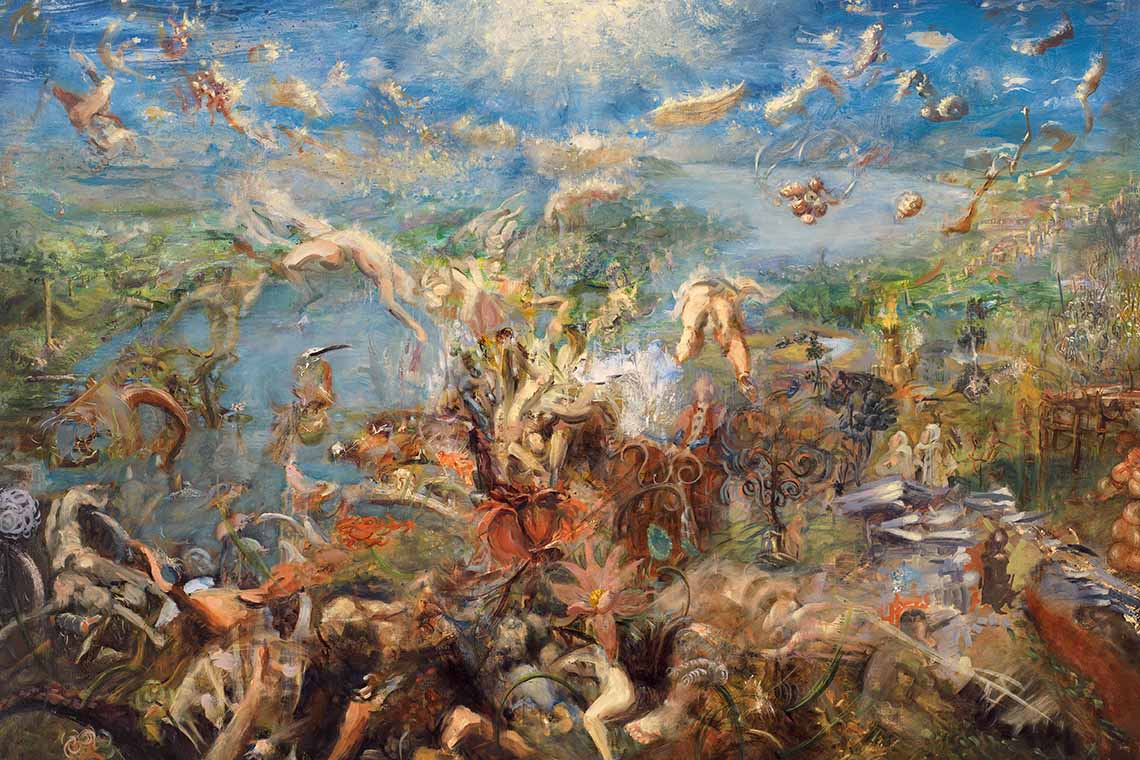The artist’s first US survey exhibition travels between various periods in his poetically abstracted lexicon.
The wind blows from all corners in The Alchemist, Ali Banisadr’s first survey exhibition in the USA. It is not just the mighty gusts of wind cutting through the upstate New York hamlet that might howl across the show’s paintings, drawings and sculptures at the Katonah Museum of Art. In the Iranian-American artist’s turbulent semi-abstractions and confronting figurations, the whirlwinds of time and place sweep and storm. Procession and instability combat each other in oil on linen paintings with no eventual winner; failure is also the sole outcome of a search for serenity. Banisadr’s universe, however, does not compromise hope: the task at the viewer’s end is to seek the snippets of sunshine through the density of paint and disarray.
Organised by the museum’s director and chief curator Michelle Yun Mapplethorpe, the repertoire on show dates as far back as 2006. The paintings from nearly two decades ago are rather hospitable to figures and light. Bright blue skies and delightful earth are subjects of Things Fall Apart and The Center Cannot Hold (both 2007). Apart from their downcast titles, the paintings contain luminosity in hue and mise-en-scène: the sun emanates from the sky, washing mortals engaging in trivial patterns. Even angels hover above the mundane landscape in which flowers also dare to bloom. There is, however, also Black, which the Brooklyn-based artist painted in the same year. In lieu of the bygone spring, he populates the surface with poetry of a collapse, a beautiful pile of debris in the aftermath of an unknown catastrophe. Down from the rubble, people descend into a hungry mass of water.

Five years later, in 2012, Banisadr painted It’s in the Air, a massive 208 x 305 cm statement of emotional typhoon. The sky here is occupied by mad birds, clapping their wings to cheer for the insanity below. There, a tempest prevails on the blindingly green grass – rush is in place and an unavailability of shelter. The artist’s technical command blossoms into disarmingly delicate gestures of contained delirium. Those who allow themselves to be absorbed by the cacophony notice his impossibly crafted strokes: in what all feels like a blink, he embodies wind, shock and escape. Each touch of paint seems like an utterance, either a barely recognisable word or a simple cry.
Banisadr’s universe has a biblical antiquity, a sense of glorious rawness in the ways his faint beings react and engage with their delirious surroundings. They belong to an epoch of un-mechanised wars and combats. The artist’s gently painted cosmos defies time, however, being rather marked and even stained by the human flaws that cut through any century. The alarmingly sanguine and lush turquoise colour human urges with a dedication to prove that they are unrestrained from any time stamp – rather, greed, anger and destruction shroud humanity’s existence like a precarious cloud. In each flow of masses and eruption of a discord, a familiarity lingers on the canvas like a shameless ghost long haunting the past and determined to stay for the future to come. Ancient suddenly feels contemporary, like a startling siren to wake us all up.

The Renaissance-era palette of luxurious hues catch all that life seems to be striving to steal. All forms of motion – drift, escape, migration – bleed gloriously into his most recent outpouring. In The Caravan (2020) and Queen of the night (2022), a nocturnal blue yields multiple shades, not unlike the ungraspable instant of a fleeting moment. The flickering brushstrokes recall a hurried escape from terror, with a balanced duet of the artist’s rounded and sharp gestures of colour. From the details arise notes of faded figuration, sometimes a recognisable fear on a vague face in the sea of panicked nomads. Some stare and others look away during their procession under a sky which the artist still makes sure to accentuate. Perhaps the sky hints at hope against all odds, a place of endless blue to look at and air to breathe.
These fragments I have shored against my ruins (2022), however, eliminates an upper void, instead, it evens out the dismay into a dreamscape. Details bear a serpent, a burning candle and even the Statute of Liberty. A continuous geometry of pink lines suggests a portal for the drifters, all huddled into a synchronised discord. Banisadr masterfully conducts the human urge to survive despite the tactility of all atrocities, unveiling the abstraction’s potential for a cerebral portrait of the very real itself.



